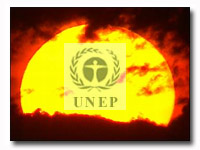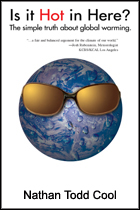GreehouseTruth Blog :: UN Climate Report Rings Media Alarm

|
|
|
|
|
UN Climate Report Rings Media Alarm
Is the IPCC AR4 report a doomsday prophecy?
Posted February 3, 2007 by Nathan Cool
 On February 2, 2007, the world's leading authority on global warming, the
Intergovernmental Panel on Climate Change (IPCC), funded in part by the United Nations Environment Programme and the World Meteorological Organization, released its latest report on our changing climate. The news wasn't exactly rosy, as credible evidence pointed out the impacts of climate change in the past century with dismal forecasts for the future. Right on cue, the media scooped up this story with slants and bias proliferating throughout the headlines. There's no doubt that the latest IPCC report is serious and shines with credibility. But before running for the hills in panic, assuredly convinced that the sky is falling--as most of the media would have you believe--it would behoove anyone concerned to step back and take a look at the whole story, and not the recent media bombardment of headline hyperbole.
On February 2, 2007, the world's leading authority on global warming, the
Intergovernmental Panel on Climate Change (IPCC), funded in part by the United Nations Environment Programme and the World Meteorological Organization, released its latest report on our changing climate. The news wasn't exactly rosy, as credible evidence pointed out the impacts of climate change in the past century with dismal forecasts for the future. Right on cue, the media scooped up this story with slants and bias proliferating throughout the headlines. There's no doubt that the latest IPCC report is serious and shines with credibility. But before running for the hills in panic, assuredly convinced that the sky is falling--as most of the media would have you believe--it would behoove anyone concerned to step back and take a look at the whole story, and not the recent media bombardment of headline hyperbole.
In all, when doing a Google News search for articles relating to this newly released report, 17,626 articles were found--now of course they can add this one to the ever-swelling stack of stories as well. Among the plethora of pieces covering the IPCC's recent calamitous chronicle of our climate were captions such as, UN Report: Humans Behind Climate Change from NPR, Climate scientists surer than ever: Man's to blame from the Kansas City Star, Humans blamed for climate change by the Guardian Unlimited, UN report blames humans from the San Diego Tribune, and my favorite, We've wrecked the weather touted by the Sydney Morning Herald.
In these articles, the journalists have done a great job at portraying the latest IPCC report as "news." The truth is though...it really isn't. The IPCC has issued these reports for years, ever since 1990 in fact. The most recent report before this latest AR4, was the Third Assessment Report (TAR) issued in 2001, which I mentioned in detail throughout chapters 5, 6 and 7 in my latest book, Is it Hot in Here? -- The simple truth about global warming. The latest AR4 report (which you can download here) is merely the fourth revision of the studies reviewed by the IPCC over the years, with their latest conclusions to tighten up their findings and projections since the TAR was released in 2001. These assessment reports have been (and will continue to be) the benchmark of most all discussions, books and documentaries regarding global warming.
When reading an IPCC report, many in the media overlook the important wording-key that tells how to interpret certain phrases. In practically all of the issues written in the AR4, phrases such as likely or more likely than not refer to a certain amount of uncertainty. For instance, using the term virtually certain means there is at least a 99% probability of occurrence, extremely likely translates to at least 95%, very likely 90%, likely 66%, more likely than not 50%, and so on. So when the IPCC says that something is "likely," they feel it has a 66% chance of being accurate with a 34% chance of not being true. The AR4, as with the TAR, is peppered with this careful wording, and yet the media in many cases seemed to ignore it on their latest mad dash to be the first on the block to cover this breaking news.
Still, the AR4, as with the TAR, is a sobering report despite the uncertainties. Yet, the majority of the media articles failed to mention that not much has changed since the 2001 report, and in some cases, things are looking just a tad brighter. For instance, the ultimate bellwether for future climate impacts, temperature, remained practically unchanged in the AR4 report compared to the previous report in 2001 (the TAR). In the TAR, the IPCC projected that by the year 2100, global average surface temperatures would increase anywhere from 1.4°C to 5.8°C. The AR4 is comparable, saying there is a likely (66%) chance that temperatures could range from just 1.1°C to as high as 6.4°C, but that the "best estimate" is for maximum, worst-case temperatures to reach 4.0°C by 2100 (1.8°C less than the prior 2001 TAR report called for).
Projected sea level rises were lightened up a bit in the AR4 as well--something though that the media didn't seem to want to mention (but I did some months back in another blog, which you can find here). According to the older report (TAR in 2001), sea level rises by the year 2100 were projected to be anywhere from 0.09 to 0.88 meters (or up to about 2.88 feet by 2100). Now though, the AR4 report has narrowed this range down to only 0.18 to 0.59 meters (or just 1.9 feet max and as little as 7 inches). The IPCC also points out that these scenarios do not take into account any future climate initiatives aimed at reducing greenhouse emissions.
What was extremely interesting though, was how some of the news stories flying about since the AR4 release referred to the human factor of global warming as being called "unequivocal" with headlines such as UN panel: Humans to blame for 'unequivocal' global warming by Monsters and Critics, Evidence is now unequivocal that humans are causing global warming by the SOP Newswire, and Science Panel Calls Global Warming 'Unequivocal' by the New York Times. This though was, to some extent, taken out of context, as the only time the word "unequivocal" is ever used in the AR4 is on page 4, where the report states:
Warming of the climate system is unequivocal, as is now evident from observations of increases in global average air and ocean temperatures, widespread melting of snow and ice, and rising global mean sea level...
The operative phrase in all of this being "climate system," which the IPCC AR4 report clarifies earlier:
Climate change in IPCC usage refers to any change in climate over time, whether due to natural variability or as a result of human activity.
Taken in full context then, the IPCC report definitively states that global warming is indeed unequivocal. The links to human causes though are a little different. The IPCC leaves some wiggle room for natural elements of climate change while bolstering their stance on human-induced causes from only a likely (66%) chance from the 2001 report to one of very likely (90%) now. It is important to note also that the AR4, as with the TAR, point out that "most" of the warming is thought to be human-induced (anthropogenic). So while there is still believed to be a natural element involved, the IPCC's report feels this is negligible; however, as pointed out in an earlier blog (which you can find here), this is still very much a confusing issue. But this isn't all that seems a bit vague within the IPCC's AR4.
When looking back over causes for extreme weather events since 1960, most were left at only about a 50% chance of being pinned on human intervention. For instance, the AR4 shows that heat waves, heavy precipitation events, droughts and tropical cyclones more likely than not have a human contribution. In other words, most of the extreme weather over the second half of the 20th century has a 50% chance of being attributed to human causes.
Additionally, the AR4 report shows that some aspects of climate don't seem to have changed at all. Back in the TAR, it was originally reported that there was a decrease in the diurnal temperature range (DTR), which is the difference between nighttime lows and daytime high temperatures. According to the AR4 though, new observations reveal that the DTR has not changed since 1979.
Antarctic sea ice also does not seem to be showing any significant changes, and the AR4 also notes that the meridional overturning circulation (also known as the Thermohaline Circulation, or THC which I discuss in chapter 3 of Is it Hot in Here?) does not appear to display any significant changes as well. Also, the AR4 notes no clear trend in the annual number of tropical cyclones, and that multi-decadal variability and the quality of tropical cyclone records before 1970 is too poor to make any definitive conclusion as to whether hurricanes have or will become more intense.
Yet, similar to the 2001 TAR, the AR4 concludes that the Earth is warming, and humans are almost assuredly playing a role. The AR4 points out that 11 of the last 12 years rank among the warmest years since records began in 1850, the average temperature in the global ocean has increased to depths of 3000 meters, glaciers and snow cover have declined, Artic temperatures have increased twice as much as the rest of the planet, and mid-latitude westerly winds have increased since the 1960s. All of this as human-produced greenhouse gas concentrations increased.
The IPCC assessment reports are serious, somber, and quite sound. Founded back in 1988, this scientific panel has led the way to bring awareness of the severity of potential climate change to policymakers around the world. It is encouraging to see the media now take notice to reports that have existed for years, but at the same time, it's disheartening to watch how they're doing it. While presenting the facts, embellishments have a way of sneaking in between the lines of reality when portrayed by those in search of ratings, and not the ultimate hunt (or portrayal) for the truth. Hype of any kind can have a severe consequential backlash, as those who cry wolf one too many times are often ignored when seriousness comes knocking on your door. Being informed on actuality--not hoopla--is far more constructive to help people stay informed, take a stand for the long term, and help preserve this wonderful planet we call home.
|
To stay abreast on similar articles like this, you can signup for the free GreenhouseTruth newsletter. Additional information on climate events, global temperatures, sea ice extent, the IPCC and other topics discussed in this blog can be found in Nathan Cool's new book, Is it Hot in Here?--The simple truth about global warming. Click here to get your copy. |

|
